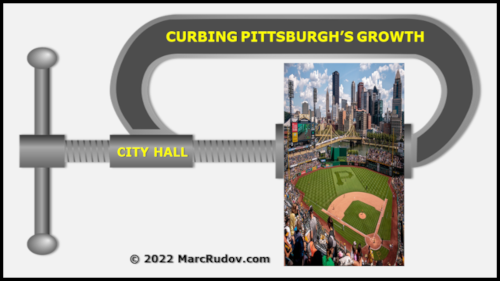
I grew up in Pittsburgh and graduated from Pitt’s engineering school. Then, I left Yinzertown for over four decades, spending most of that time in the Boston area and in Northern California.
In those locales, I witnessed steady growth, via nonstop real-estate construction and ever-expanding highways — none of which occurs without significant upticks in population.
Upon my return to Pittsburgh, in November 2019, I had to refamiliarize myself with the area. Here’s what stood out beyond all else: the Parkway, built in 1958, still is two lanes on each side; the overhead signs on the Fort Pitt Bridge were there when I was a child. I remember, in the 1970s, when Pittsburgh was the third-largest corporate-headquarters city in America, behind New York City and Chicago. Then, the city deindustrialized, and companies moved out.
Shrinkage
What’s going on here?
Shrinkage, as they said on the “Hamptons” episode of Seinfeld.
What is curbing Pittsburgh’s growth?
From what I can see, it’s City Hall, controlled by Democrats since 1934. Layer upon layer of local government bureaucracy, plus backstabbing politics, make the process of real-estate development difficult, lengthy, and expensive.
A city that doesn’t grow limits economic opportunity, compelling fresh college graduates to leave town with their sheepskins and repelling outsiders from moving to and investing here.
According to the US Census, Pittsburgh proper has been shrinking since 1950 and hasn’t seen growth above 1% since 1930. It’s as if this stasis is intentional.
Notwithstanding its static state, the Economist, in September 2019, named Pittsburgh the third-most livable city in the United States and 34th in the world. Clinging to this accolade, however, has induced industrial inertia and is dangerous for Pittsburgh’s brand.
Let’s look at the numbers in graphical form, both Pittsburgh proper and metro. The first figure shows that Pittsburgh proper peaked in 1950 and has declined precipitously since then. In the second figure, we see that metro Pittsburgh grew from 1990 to 2000, because of suburb expansion, but declined after that. Moreover, the UN has forecast that metro Pittsburgh will grow at a rate of 15 percent between 2022 and 2035 — a rate that belies reality. The development in the Strip District and Robotics Row, two bright spots, is unlikely to compensate for the overall trend of declining population. Notice also that, between 2010 and 2020, 13.4 percent of blacks and 5.6 percent of whites left town, and other races, especially Hispanics, moved in.
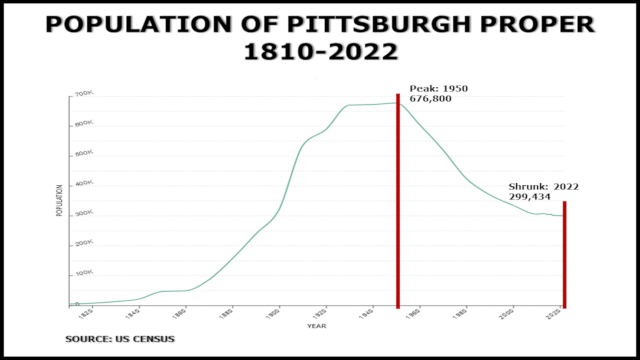
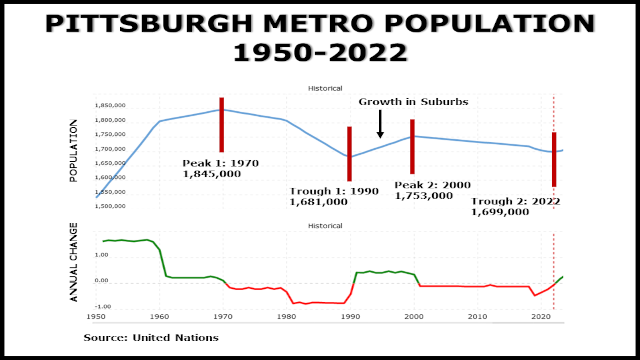
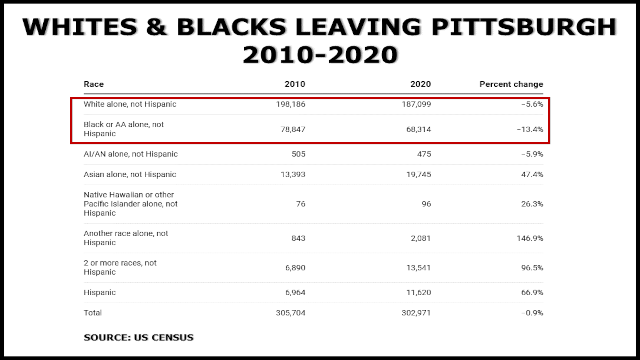
Uptown-Tito Hoax
Nothing epitomizes Pittsburgh’s seemingly intentional desire not to expand than the hoax being perpetrated in the Uptown district of Pittsburgh.
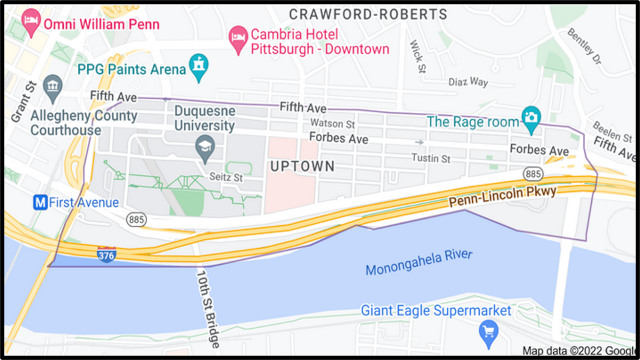
In September 2017, Pittsburgh City Planning created the EcoInnovation District (a portmanteau of EcoDistrict and Innovation District) in Uptown: a community plan with a focus on healing the environment, supporting the needs of existing residents, and expanding job growth. Healing the environment, whatever that means, and expanding job growth simultaneously? Woke gobbledygook.
EcoDistricts is an organization headquartered in Portland, Oregon, where BLM and Antifa had free reign to burn down entire blocks, and the homeless openly live in tents with impunity. Great model, huh? In my experience, other than getting media attention, government committees — in fact, all committees — never accomplish anything useful, timely, or inexpensive.
A big contributor to this EcoInnovation Plan was Pittsburgh’s Urban Redevelopment Authority (URA), whose stated goals are creating jobs, increasing the city’s tax base, improving the vitality of the city’s businesses and neighborhoods, and improving the city’s livability as a whole. Keep these goals in mind as you read further.
In May 2020, Uptown Partners, (UP) a registered community organization (RCO), filed a petition for conservatorship to take over a dilapidated, abandoned house at 1817 Fifth Avenue (photo below), using a Pennsylvania law (2008 Act 135). In this petition, UP indicated a willingness to demolish the house and sell the property to a developer.
My investigation leads me to conclude that RCOs, which live off of donations, exist mainly to follow woke agendas (e.g., heal the environment) and to impede, extort, and repel real-estate developers.
Along came Fountain Residential Partners, of Dallas, Texas, which proposed building an $89-million, 260-unit, mixed-use property on that site and 22 adjoining sites, at the corner of Fifth Avenue and Dinwiddie Street. This new development (artist rendering below) would incorporate 11,000 square feet of commercial space, including a grocery store. In other words, this revitalized property would create jobs, increase the city’s tax base, improve the vitality of the city’s businesses and neighborhoods, and improve the city’s livability as a whole.
BEFORE AND AFTER (maybe)
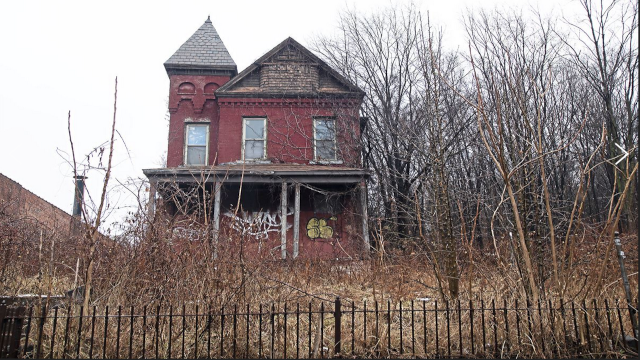
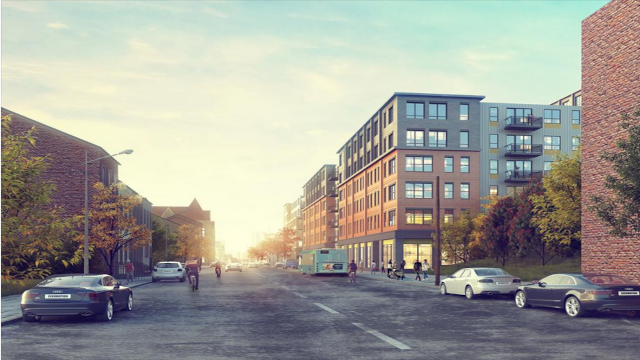
Well, it turns out that UP’s conservatorship petition was flawed, to be kind. The lawyer representing UP, Wayne Cobb, didn’t serve the new owners, Nicole McGuire and James McGuire Jr., who live in Pittsburgh and inherited the house at 1817 Fifth Avenue (see photo above) and underlying property from their father, James McGuire Sr. — who lived in Houston, Texas, and died there in 2014. In a document in the petition, Cobb falsely certified that he had successfully served the deceased James Sr. in Houston, in April 2019, thereby invalidating the petition.
According to Pat Rega, the lawyer representing the McGuire siblings, there was a status conference in August 2021, in front of Judge John McVay, to attempt to resolve this matter. Instead of summarily dismissing the case, which I believe he should have done, McVay gave the parties time to resolve the matter.
It seems to me, there’s nothing to resolve: the petition is invalid because of blatant misrepresentation by Cobb. The McGuire siblings want to sell the property. A hearing is pending before Judge McVay to determine the fate of this petition. Waste of time and taxpayer money. And, it jeopardizes the expensive plans of Fountain Residential Partners — and hurts Pittsburgh’s growth.
Here’s where this saga becomes even more bizarre.
In my opinion, to save face and create a distraction and diversion over the conservatorship disaster, Brittany McDonald, executive director of Uptown Partners, pivoted. She hired David Rotenstein — historian-for-hire and folklorist — to generate a mythology about the property and convert it to a historical landmark. Full disclosure: I emailed Brittany McDonald to request a copy of her conservatorship petition. She never responded. I got it from another source.
In November 2021, Rotenstein submitted a 120-page application for the Tito-Mecca-Zizza House, which designates Sal (died on November 25, 2021) and Irene Williams as owners of the Tito House-adjacent garage at 1818 Colwell Street, and incorrectly designates James A. McGuire of Houston (deceased in 2014) as the owner of the house. You can’t make up this stuff! Moreover, on January 26, 2022, Rotenstein made a one-hour-18-minute videotaped presentation to Uptown Partners to highlight his folklore application.
To make a long story very short, this folklore centers around Joe Tito (Italian numbers-runner and money-launderer, who became a Rolling Rock distributor) and Gus Greenlee (black builder of a short-lived ballfield for the Pittsburgh Crawfords of the Negro Baseball League), who were business partners in the 1920s. Their story is interesting but not enough to merit a display or mention in the Heinz History Center, the preeminent history museum in Pittsburgh. In fact, the curator of this museum told me she had never heard of Tito and Greenlee until articles about the Tito House surfaced within the last year.
More significant: in UP’s petition for conservatorship, there is NO mention of Tito and Greenlee. None. The desired property was merely a crappy house that UP was happy to demolish and sell to a developer. Let that sink in.
Chip Desmone, a top architect in Pittsburgh, estimated that rehabbing this so-called Tito House would cost $2.5M to $3.5M (the dilapidated house is worth $55K). Nobody in his right mind will pay this outrageous sum.
After Pittsburgh’s Historic Review Commission (HRC) voted 4-1 to reject the historic designation of the so-called Tito House and garage, in January 2022, the City Planning Commission ignored HRC and unanimously voted to send the historic designation to the Pittsburgh City Council for approval. Rumor has it that Mayor Ed Gainey, who was sworn into office on January 3, 2022, favors this outcome. I emailed Gainey and his media director for verification: no responses.
If, unfortunately, the historic designation actually materializes, the McGuire siblings, who own and want to sell the house to Fountain Residential Partners, will be forced to fund the ridiculous $3.5M upgrade, likely ruining them financially. Outrageous and unfair. Said Nicole McGuire, “My father bought this property with the expectation that it would some day be developed. It makes me sad. My parents worked very hard. As a black family, we are very much against this.”
If, however, by some magic (maybe the cash will rain down from a helicopter) this shack is restored, no locals or tourists will pay to visit it. And, who would be stuck with the maintenance tab? The taxpayers, of course.
The result of such an obviously political and stupid hoax: no creation of jobs, no increase in the city’s tax base, no improvement of the vitality of the city’s businesses and neighborhoods, and no improvement of the city’s livability as a whole — in other words, continued, intentional curbing of Pittsburgh’s growth.
Squeezing Developers
The Tito story above underscores the difficulty developers encounter when trying to build anything in Pittsburgh. There’s no excuse for throwing unnecessary roadblocks in front of capitalists, if a city wants to grow and attract new citizens and more investment dollars. Yet, Pittsburgh does this.
The flowchart below depicts the process for getting real-estate projects approved in Pittsburgh. The process for a straightforward project — nonvariance, by-right, by-code — (on the left side of the diagram) takes at least six to eight months. Any variance can add six months, meaning over a year just for approval. How many developers give up and go away? Throw a historic designation into the works (on the right side of the diagram), which can add at least six months to the process on the left, and the situation becomes economically untenable for most developers. Does anyone in City Hall even care about other people’s money and time? It seems not.
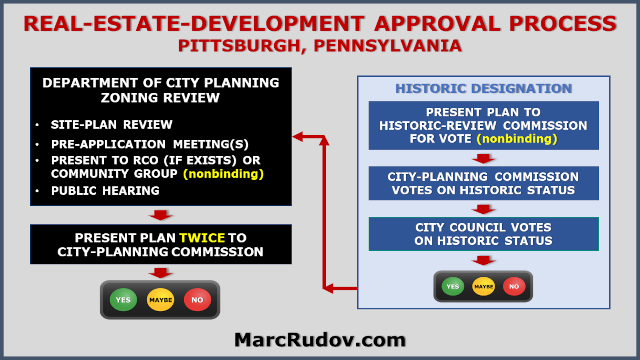
Parting Advice to Pittsburgh Bureaucrats
If the unimportant Tito/Greenlee saga merits a place in Pittsburgh’s history, let the Heinz History Center executives decide if they should make a small display to memorialize it.
What must not happen: designating the Tito House and adjoining garage a historical site. This would hurt the city and send a “stay away” message to real-estate developers, who actually improve Pittsburgh.
As a reference point, all that remains of the great, historical Forbes Field, home of the Pittsburgh Pirates from 1909 to 1970 and the Pittsburgh Steelers from 1933-1963, is a small portion of the outfield wall and a plaque, neither of which interfered with the construction of Pitt’s Katz Graduate School of Business.
Pittsburgh famously has 446 bridges, many of which are in need of repair. A shrinking population means that the remaining citizens will be on the hook to pay for these repairs, and many others, at a higher cost/citizen — not to mention the added penalty of inflation. To this point, the Pittsburgh Post-Gazette reported: Mayor Ed Gainey said, on March 3, 2022, that he’s so concerned about the condition of the city’s bridges that he asked the state House Democratic Policy Committee to meet in Pittsburgh the following week to discuss whether the state can help the city pay for needed bridge repairs.
Compounding this issue, about 40 percent of Pittsburgh’s land is tax-exempt. Highmark, UPMC, the University of Pittsburgh, and Carnegie Mellon University, combined, own billions of dollars in tax-exempt property. Who picks up the slack? Taxpayers. So, the vicious cycle of increasing costs & taxes, and a declining population, drive even more people and businesses out of the city.
It doesn’t end there. Pittsburgh’s anti-growth bureaucracy is ballooning in unproductive ways (quite a contradiction). To wit: Mayor Gainey recently and quietly created an exclusionary, unconstitutional organization called Black Pittsburgh Matters. Doesn’t all of Pittsburgh matter? Apparently not.
Bottom line: If Pittsburgh’s elitist bureaucrats want to continue curbing the city’s growth, and stifling its brand, their strategy is working.
POSTSCRIPT #1 (03/10/22): Why US Steel and Other Companies Avoided Business-Unfriendly Pittsburgh
POSTSCRIPT #3 (04/20/22): City Council Hears Arguments Over Bogus Historic Nomination of Tito House
POSTSCRIPT #5 (03/31/23): Allegheny County’s Population Dropped by 12K in 2022
POSTSCRIPT #6 (04/03/23): Allegheny County Has Lost 50K Jobs in Last Five Years
POSTSCRIPT #7 (07/21/23): How Fountain Residential and Uptown Partners Saved the Tito House
© 2022 Marc H. Rudov. All Rights Reserved.
About the Author

Marc Rudov is a branding advisor to CEOs,
producer of MarcRudovTV, and author of four books

